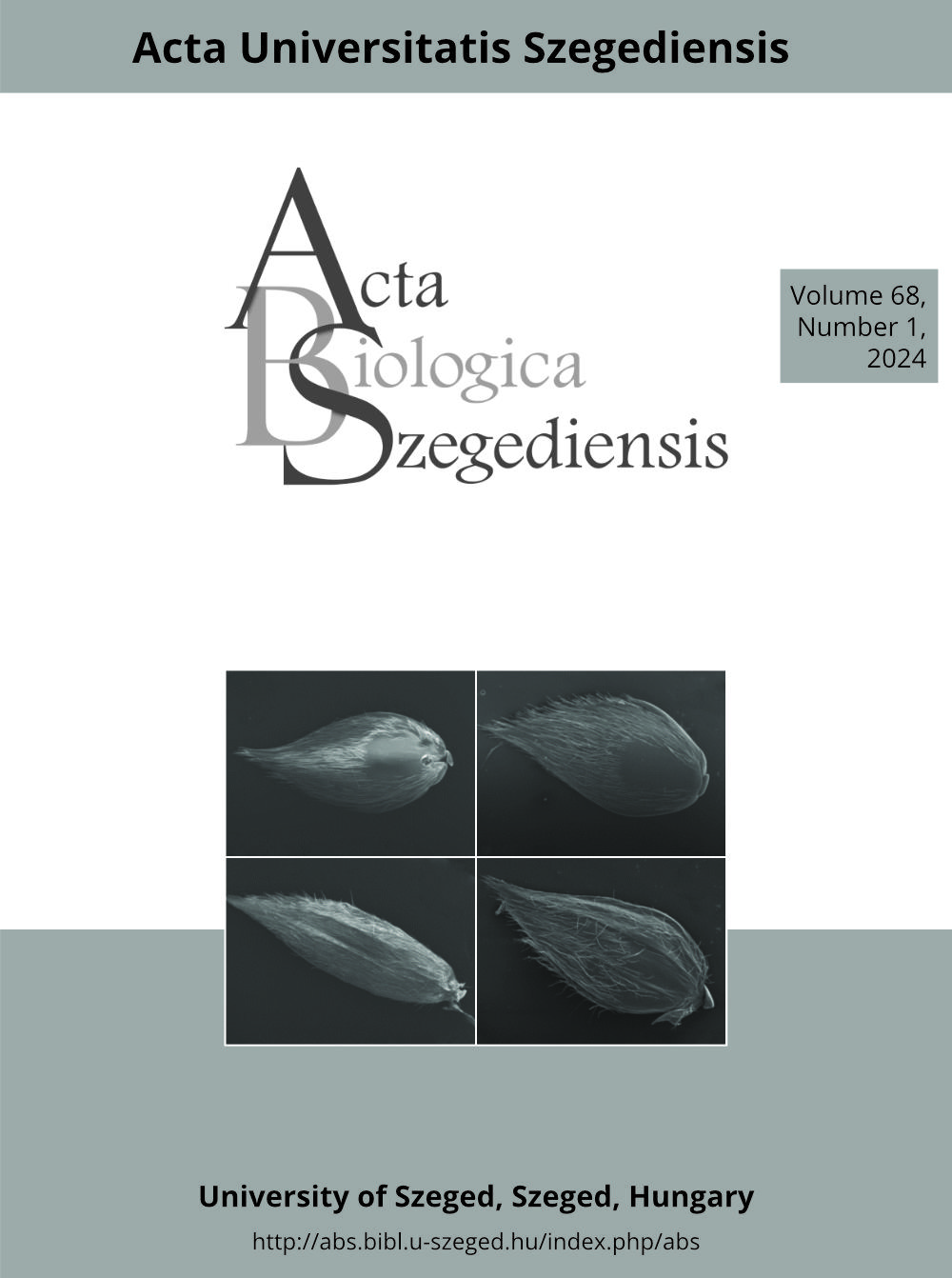Effect of palm peat as an alternative substrate for coconut peat on the morpho-physiological parameters of Cucumis sativus L. (Cucurbitaceae)
DOI:
https://doi.org/10.14232/abs.2024.1.31-37Keywords:
coco peat, cucumber, hydroponic, palm peat, soilless cultivationAbstract
Soilless cultivation offers a viable alternative to soil-based methods for greenhouse crops. Palm peat has potential as an organic substrate in hydroponic systems, providing an alternative to conventional substrates like coconut peat. Cucumis sativus (cucumber) is a widely cultivated plant with significant nutritional value globally. This study evaluated the effects of two substrates—palm peat and coco peat—compared to soil (control) on the morphological and physiological characteristics of cucumber plants under greenhouse conditions in a completely randomized design. Key parameters, including plant height, number of lateral branches, leaf number and diameter, and fruit number and width were assessed at three intervals (15, 45, and 70 days). Additional parameters were measured on the 60th day. Analysis of variance (ANOVA) revealed significant differences in the physical and biochemical properties of the substrates, including EC, BD, pH, CEC, and WHC. Significant treatment effects were also observed on plant height, number of lateral branches, root fresh weight, leaf number and diameter, fruit number, width, and weight, as well as proline content. However, differences in relative water content (RWC), root dry weight, chlorophyll, and carotenoid content were not significant. This study highlights the positive influence of cultivation substrates on cucumber growth and development. Palm peat emerged as a promising cost-effective alternative to coco peat in soilless cultivation systems.
Downloads
References
Asaduzzaman M (2015) Soilless culture: use of substrates for the production of quality horticultural crops. BoD – Books on Demand, InTech Publisher, Rijeka, Croatia.
Aydi S, Sassi Aydi S, Rahmani R, Bouaziz F, Souchard JP, Merah O, Abdelly C (2023) Date-palm compost as soilless substrate improves plant growth, photosynthesis, yield and phytochemical quality of greenhouse melon (Cucumis melo L.). Agronomy 13(1):212.
Badgery-Parker J, James L, Jarvis J, Parks S (2015) Commercial Greenhouse Cucumber Production, 2010 Edition, NSW Agriculture.
Bates LS, Waldren RPA, Teare ID (1973) Rapid determination of free proline for water-stress studies. Plant Soil 39:205-207.
Burrage SW (1998) Soilless culture and water use efficiency for greenhouses in arid, hot climates. In: International Workshop on Protected Agriculture in the Arabian Peninsula, Doha (Qatar), 15-18 Feb 1998, ICARDA.
Elabed N, Bouaziz F, Bouri M, Boukhris A, Aydi S, Belkadhi MS (2022) Date palm waste compost: a promising alternative for coconut fiber as growing media of melon. Ital Hort 29:26-34.
Goddek S, Joyce A, Kotzen B, Burnell GM (Eds.) (2019) Aquaponics food production systems: Combined aquaculture and hydroponic production technologies for the future. Springer Cham, pp. 619.
Islam S, Khan S, Ito T, Maruo T, Shinohara Y (2020) Char-acterization of the physico-chemical properties of environmentally friendly organic substrates in relation to rockwool. J Horti Sci Biotech 77(2):43-148.
Karakaş C, Özçimen D, İnan B (2017) Potential use of olive stone biochar as a hydroponic growing medium. J Analyt Appl Pyrolys 125:17-23.
Krumrei M (2019) Hydroponics: Effect of pH on Different Cucumber Varieties. Undergraduate Thesis, University of Nebraska, Lincoln, USA.
Masmoudi S, Jarboui R, El Feki H, Gea T, Medhioub K, Ammar E (2013) Characterization of olive mill wastes composts and their humic acids: stability assessment within different particle size fractions. Enviro Techn 3 4 (6 ) :78 7-7 9 7.
Mohammadi Ghehsareh A, Hematian M, Kalbasi M (2012) Effect of date palm wastes and rice hull mixed with soil on growth and yield of cucumber in greenhouse culture. Int J Recycl Org Waste Agric 2:17.
Najar R, Aydi S, Sassi-Aydi S, Zarai A, Abdelly C (2019) Effect of salt stress on photosynthesis and chlorophyll fluores-cence in Medicago truncatula. Plant Biosys 153(1):88-97.
Olympios CM (1999).Overview of soilless culture: advantages, constraints, and perspectives. In Choukr-Allah R (Ed.), Protected Cultivation in the Mediterranean Region, CIHEAM/IAV Hassan II, Paris, Europe, pp. 307 -324.
Putra PA, Yuliando H (2015) Soilless culture system to support water use efficiency and product quality: a review. Agri Sci Proc 3:283-288.
Ritchie SW, Nguyen HT, Holaday AS (1990) Leaf water content and gas‐exchange parameters of two wheat geno-types differing in drought resistance. Crop Sci 30(1):105-111.
Savvas D, Gianquinto G, Tuzel Y, Gruda N (2013) Soilless culture. In Good Agricultural Practices for Greenhouse Vegetable Crops. FAO Plant Production and Protection Paper 217 (Rome, Italy: FAO), 303-354.
Wang D, Gabriel MZ, Legard D, Sjulin T (2016) Characteristics of growing media mixes and application for open-field production of strawberry (Fragaria ananassa). Sci Horti 198:294-303.
Wang SL, Ku SS, Ye XG, HE CF, Kwon SY, Choi PS (2015) Current status of genetic transformation technology developed in cucumber (Cucumis sativus L.). J Integ Agri 14(3):469-482.
Wdowikowska A, Reda M, Kabała K, Chohura P, Jurga A, Janiak K, Janicka M (2023) Water and nutrient recovery for cucumber hydroponic cultivation in simultaneous biological treatment of urine and grey water. Plants 12(6):1286.
Yang T, Altland JE, Samarakoon UC (2023) Evaluation of substrates for cucumber production in the Dutch bucket hydroponic system. Sci Horti 308:111578








